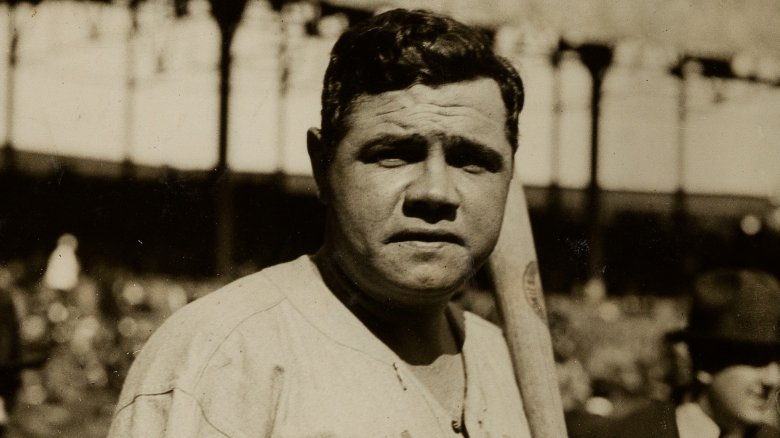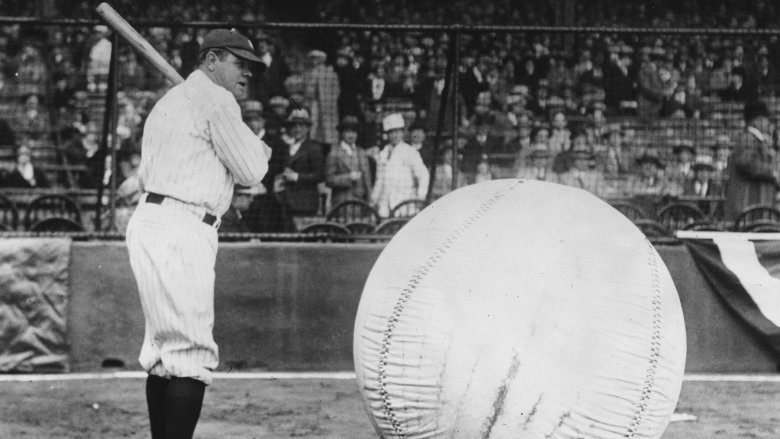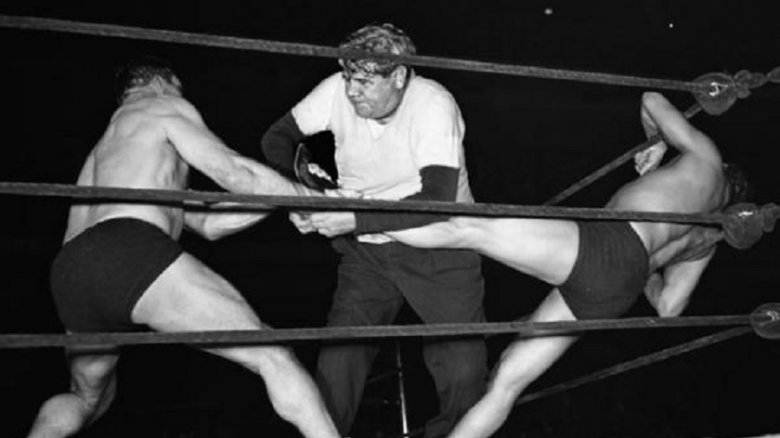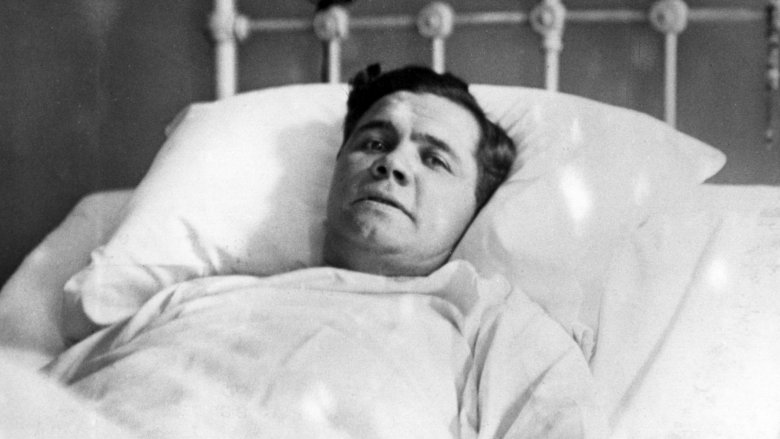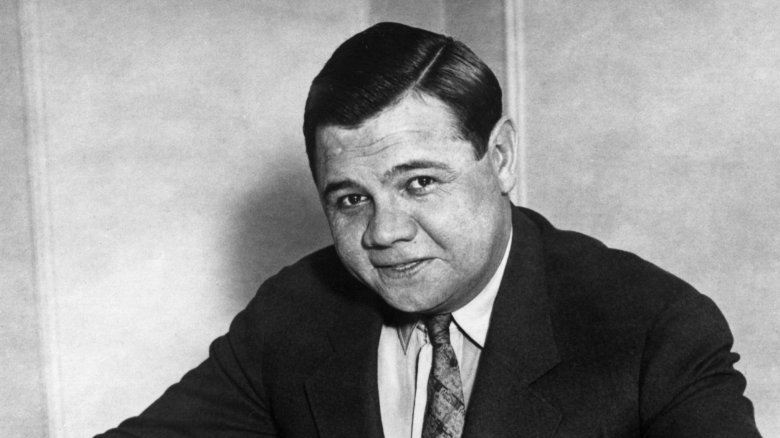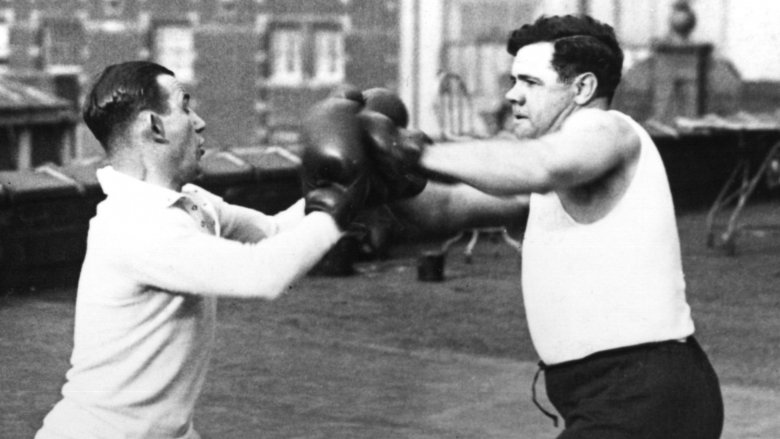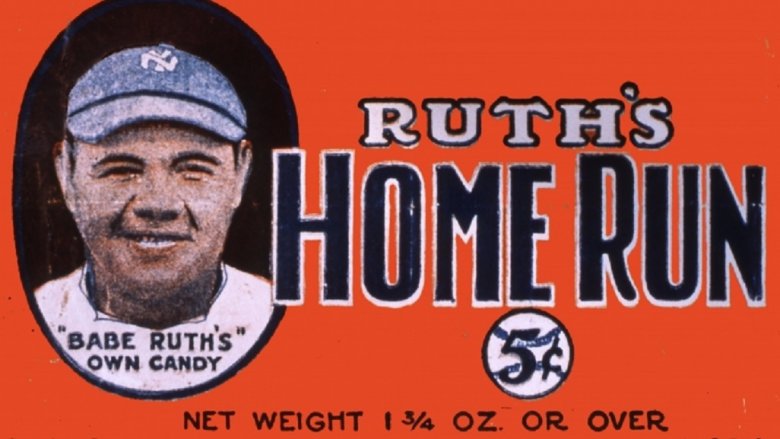The Untold Truth Of Babe Ruth
Sports buffs recognize Babe Ruth as the brightest star of the baseball's Golden Age. He was one of a kind, kind of ridiculous, and ridiculously talented. He pitched, hit, and partied harder than any player of his day, breaking both baseball records and hearts along the way. He erred like any human, but his ERA was divine. Physically large and larger than life, Ruth earned a permanent spot in sports history. But his story transcends stats and status, tapping into both the fundamental flaws and the fierce fantasticality of humanity itself.
The details of his life are in dispute
Babe Ruth's life reads like a gritty fairytale: an indigent orphan with a penchant for crime becomes one of the greatest ballers and shot callers of all time. It's practically Horatio Alger on steroids. But part of what makes that tale so fantastic is that some of the "facts" are pure fantasy. As Wilborn Hampton wrote in the book Babe Ruth, "so much was written about Babe Ruth that it's hard to know what is real and what is myth."
A number of rumors about Ruth are probably unverifiable, like the claim that he had a giant Johnson. However, certain assertions are certainly false. For example, Ruth wasn't an orphan. He did spend years at a school for boys, but only because he was (by his own admission) "a bad kid." Reporters also wrongly asserted that Ruth's legal name was George Herman Ehrhardt, an allusion to his German ancestry. Ruth further fueled confusion by making misleading statements.
To make matters worse, Ruth had a "hazy memory" and inconsistently recalled the past. It also didn't help that he sometimes willfully rejected reality. Take, for instance, Ruth's birth date. For the bulk of his life Ruth believed he was born on February, 7, 1894. But official records listed the date as February, 6, 1895. Undeterred by this revelation, Ruth simply celebrated his birth on the wrong day. Writers responded to the various contrivances and fact gaps by creating their own conflicting and sometimes cockamamie versions of reality.
He once injected himself with a sheep testicle extract
Ruth wasn't called the Sultan of Swat for nothing. The man obliterated balls with ease and changed the way baseball was played. As Smithsonian Magazine pointed out, Ruth set dozens of records in his prime. In 1920 (his first year with the Yankees) he hit more homers "on his own" than every team in the league besides the Phillies. Per the History Channel, Ruth's 714 career home runs remained unbeaten for 39 years. On top of all that, he'd been a record-setting pitcher with the Red Sox.
Ruth wasn't content with raw power and unparalleled prowess, however. According to author David Zirin, the beastly batter sought an unfair edge with his era's equivalent of steroids. Ruth's cheat of choice: sheep testicle extract. In an interview with NPR, Zirin explained that the science of steroids was still relatively new. Originally explored as a way to increase worker productivity during the Industrial Revolution, steroids caught the attention of the sports world during the 1920s. The prospect of enhanced abilities proved irresistible to Ruth, who desired not only to hit harder but to be harder during sex.
Unfortunately for Ruth, sheep testicles didn't hold the key to better ball hitting or boot-knocking. A single shot of the stuff severely sickened him, giving a whole new meaning to the term "foul ball." Embarrassed, the Yankees passed off Ruth's resulting illness as "one of his famous bellyaches." So maybe he was Horatio Alger on steroids.
He refereed pro wrestling matches
In June 1935, Ruth bitterly bid farewell to baseball. Earlier that year he returned to Massachusetts to play for the Boston Braves. As part of the arrangement he would act as the organization's vice president and assistant manager. But what seemed like a sweet deal "quickly soured," according to Time. Intense acrimony between Ruth and Braves president Judge Fuchs drove Ruth to quit. The New York Daily News reported that he didn't want to abandon baseball; he simply wanted to work elsewhere.
Unfortunately, elsewhere wasn't an option. As Bleacher Report's Ryan Dilbert detailed, Ruth spent the next decade in professional purgatory. He tried to occupy himself with golf, bowling, and radio show appearances, all the while hoping that baseball would welcome him back. It didn't, but pro wrestling partly filled the void with fat checks and fawning fans.
On two separate occasions in 1945, Ruth got hired to referee wrestling matches. It was familiar territory for the sensational slugger, who had done similar gigs during his baseball career. But now he was a megastar, and the masses flocked to see him in the ring. Ruth didn't disappoint. He actively involved himself in the action, separating wrestlers and laying down the law. During his second appearance, he narrowly avoided a kick to the jaw and put a performer in a headlock. Just as he had in baseball, Ruth shined brightly in the ring. But his light would soon fade as he succumbed to cancer.
He was one of history's first chemotherapy patients
In 1946, Ruth again tried to reconnect with baseball. Reffing wrestling matches had given him something to do, but the squared circle had nothing on the diamond. He wanted to manage a team, not manhandle men. In the end he didn't manage to do either. As The New York Times detailed, Ruth's health began drastically declining. He started losing his ability to speak and swallow. Pain plagued his left eye. Initially these issues were attributed to dental trouble, and Ruth had three teeth removed. The root cause was far worse.
Ruth had naso-pharyngeal cancer (which many people later mistook for throat cancer). A tumor had grown at the base of his skull, and his lymph nodes ballooned. Unable to eat, the once-robust batter lost 80 pounds. He didn't know what he had (and doctors didn't tell him), but he knew it was serious. So he agreed to try a newfangled treatment called chemotherapy along with radiation. Ruth realized it might fail but hoped it would help others down the line.
The Sultan of Swat suffered horribly. Cancer crippled the nerves in his neck, and his hair fell out due to radiation. In 1947 things started looking up, though. Doses of the drug teropterin reversed some of his debilitating symptoms. He even recovered enough to help open Yankee Stadium. Sadly, his resurgence didn't last. Ruth died in 1948. But as one of history's first chemotherapy patients, he helped usher in an era of life-saving cancer medications.
The manager that never was
It's tempting to speculate about what would have happened had the Babe beaten cancer. Maybe he would have achieved his dream of managing a baseball team. However, his adopted daughter Julia Ruth Stevens believed that race relations stood in Ruth's way. As CBS summarized, evidence suggests that Ruth might have fought for racially integrated baseball teams, which likely would have prompted the powers that be to shut him out.
CBS didn't delve deeply into said evidence, simply noting that Ruth's second wife Claire vehemently vouched for her husband. But it's worth noting that Ruth regularly went out of his way to interact with black athletes in an age when many whites spurned them. According to the book Sport and the Color Line, the Babe enjoyed barnstorming (playing exhibition games) against black ballplayers and spoke highly of them. He "even met publicly with black boxer Harry Wills in 1924." As The New York Times noted, Ruth also befriended black actor and tap-dancer Bill "Bojangles" Robinson, who became an honorary pallbearer at Ruth's funeral.
Obviously, none this proves what Ruth would have done as a manager, but it lends credence to the notion that he supported desegregation. At the very least it's plausible that such views hurt his chances of running a team, a position that runs counter to the longstanding stance that Ruth was just too rowdy. If things had gone differently, he might have continued making baseball history.
He accidentally made history by punching an umpire
Whether hitting home runs, hitting on women, or hitting the sauce, Ruth always swung for the fences. He also swung at faces occasionally. As Vice explained, Ruth had ruffian roots. As a child he stole things and skipped school so often that by age 7 he was "legally declared 'incorrigible or vicious.'"
As an adult the Sultan of Swat became a duke of debauchery and put up his dukes when angered. In 1922 an ornery Ruth leaped into baseball bleachers mid-game and challenged the crowd to a fight in response to heckling. He also got suspended for sassing umpires. An especially memorable outburst occurred in 1917 when he furiously slugged an official. Per MLB.com, Ruth was a Red Sox pitcher at the time. During the first inning of a game against the Washington Sentinels, he upbraided umpire Brick Owens and got ejected.
An enraged Ruth tried to make good on a promise to "bust [Owens] on the nose]" if ousted. Instead he hit the ump behind the ear. The Washington Times reported that a manager "and several policemen had to drag Ruth off the field." Much to the battered umpire's relief, replacement pitcher Ernie Shore stuck to striking out players. In the process he recorded major league baseball's first ever combined no-hitter (i.e., involving multiple pitchers), per SB Nation. That's an uncommon accomplishment. Between 1876 and 2017, there were 11 combined no-hitters. Ruth became part of that history by throwing a hissy fit.
His sex life landed him hot water
Nobody bats a thousand in the bedroom, but Babe Ruth might have bedded 1,000 women. In The House That Ruth Built, author Robert Weintraub recounted Ruth's legendary appetite for food and fornication. As Weintraub described, "Nothing suited Ruth more than a large meal followed by a trip upstairs to a whore's boudoir" for dessert, as it were. He supposedly once entered a St. Louis brothel and then entered every worker in it. While visiting Arkansas, he would cruise along the countryside for country girls and chicken dinners.
Ruth didn't have to root out women, though. They threw themselves at him like lascivious screwballs. Females flooded him with letters declaring their desire to mount his flesh mound. He had no shortage of options. That didn't stop the ballplayer from making errors, however. Per a former Red Sox teammate, Ruth would "stick his thing into anything that had hair on it," even if that "thing" had a husband. In 1921, he romanced the wife of a Louisiana politician, assuring her that "she was the only one." When she discovered Ruth's ruse, she grabbed a butcher knife and chased him onto a train. In a separate incident, "an irate husband waving a revolver chased a near-naked Babe out of a hotel."
It's a minor miracle that Ruth didn't catch a whole brothel's worth of venereal diseases. But he still may have paid a steep price. According to The LA Times, an alleged "intestinal disorder that sidelined Ruth seven weeks in 1925" might have actually been syphilis.
The Babe and the baby
Given Ruth's prolific womanizing, you might assume he fathered a billion babies. But he's only known to have sired a single daughter, Dorothy Ruth Pirone. As the Hartford Courant recounted, Pirone was conceived during Ruth's extramarital affair with an also-married hand model named Juanita Jennings. However, Ruth and his absurdly tolerant first wife hid this fact from Pirone, portraying Jennings as a family friend. According to The New York Times, Pirone didn't discover the truth until age 59.
Perhaps Pirone had secret siblings as well, children her philandering father might not even have known about. If so, none of them or any of Ruth's known mistresses came forward. But in 1923, 19-year old sales clerk Delores Dixon sued Ruth for purportedly impregnating her. As The New York Daily News described, Dixon accused Ruth of sexually assaulting her on multiple occasions and telling her to "go to hell" upon discovering she was carrying his kid. Dixon further alleged that Ruth rendered her despondent and disabled. She demanded $50,000 in compensation.
Ruth denied Dixon's allegations and promised to "fight that case to the last ditch." But beneath his confident veneer was a man beset by stress and bad press. The only thing that saved him from getting buried in bad publicity was the tragic death of a beloved Broadway performer, which dominated the headlines. Before long, Dixon disavowed her story, and after signing a formal confession, she "disappeared from the city."
The Babe and Baby Ruth
Three years after Ruth was sued for purportedly making a baby, the makers of the Baby Ruth candy bar took him to court. As the History Channel elaborated, Ruth tried to capitalize on his stratospheric fame by starting the George H. Ruth Candy Company, which was slated to sell "Ruth's Home Run Candy." The candy's planned packaging featured Ruth's grinning visage and the words, "Babe Ruth's Own Candy."
The Curtiss Candy Company cried foul. It had made a fortune selling Baby Ruth bars and worried that competition from Babe Ruth would compromise its $1 million in monthly profits. To preempt this possibility, the company sued him for copyright infringement. At first sniff the suit stinks of poopy poppycock. After all, the crack-like popularity of Baby Ruth bars probably stemmed from Babe Ruth's celebrity. However, The Curtiss Candy Company claimed it named the candy bar after Ruth Cleveland, the daughter of ex-president Grover Cleveland.
In fairness, Cleveland was nicknamed Baby Ruth during her infancy. But as noted by the book Candy: A Century of Panic and Pleasure, the Curtiss Candy Company didn't trademark the Baby Ruth brand until 1919. By that time, Ruth Cleveland had been dead for roughly 15 years, and Babe Ruth was already an accomplished pitcher for the Red Sox. The company conceded that Ruth's fame may have helped boost sales but maintained that he didn't inspire the candy bar's name. That argument proved persuasive, and the court ruled against Ruth in 1931.
The girl who bested Babe Ruth
Ruth experienced a number of deflating defeats in 1931. His sugar-coated dreams got crushed by the Curtiss Candy Company. Despite the Ruth and the Yankees scoring the most runs in a season in major league history, per Bleacher Report, the team failed to reach the World Series. Perhaps most memorably, a teenage girl seemingly struck out the Sultan of Swat.
Smithsonian Magazine specified that the strikeout took place during an April exhibition game between the Yankees and minor league team called the Chattanooga Lookouts. In the lead-up to that encounter, Lookouts president Joe Engel employed 17-year-old Jackie Mitchell as a ploy to boost ticket sales. Mitchell was a formidable pitcher with a school baseball background and a killer curveball. Since no rules prohibited female participation on male teams, including her was fair game.
Despite being a minor from the minor leagues, Mitchell didn't bat an eye when picked to play against Babe Ruth. She confidently whizzed pitches past the increasingly frustrated franchise player. When the strike count hit three, the Sultan of Swat threw "his bat down in disgust" and "retreated to the dugout." Mitchell then struck out the great Lou Gehrig with equal ease. Reactions to this unexpected feat ranged from bemused excitement to dismissive amusement. Newspapers ultimately settled on the narrative that Ruth and Gehrig went easy on the girl. However, neither player corroborated that claim. Perhaps tellingly, after possibly besting two of history's best male batters, Mitchell was effectively banned from professional baseball.
Ruth might not have called his famous shot
Ruth wore his greatness like a uniform. He was the kind of guy who would knock a ball into outer space and then jauntily round the bases like he owned the place. For instance, after hitting a historic 60th home run during the 1927 season, Ruth made a "triumphant, almost regal tour of the paths" while fans showered him with effusive praise, per The New York Times. He was charismatic, confident, and seemingly unconquerable.
Ruth's most dazzling display of dominance went down during the 1932 World Series, when the Sultan of Swat supposedly "called his shot." As The Chicago Tribune described, it happened during a Game 3 showdown between the New York Yankees and the Chicago Cubs. Ruth was pitted against Cubs pitcher Charles Root. Hostility literally filled the air as contemptuous Cubs fans lobbed lemons and spat at Ruth. The battered batter reportedly pointed at the outfield repeatedly before hitting the "most stupendous home run in the history of baseball."
The epic homer essentially sealed the series' outcome and immortalized Ruth, who had apparently bent a baseball to his will. However, according to author and sportswriter Ed Sherman, appearances may have been deceiving. Pitcher Charles Root fervently denied that Ruth called his shot and called the story a lie for the rest of his life. There's video footage of the event (above), but it's ambiguous at best. Even if Ruth didn't actually call his shot, he definitely meant to maul that ball.
